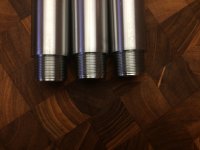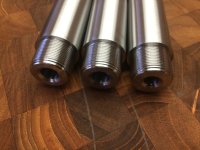Pete,An old toolmaker friend suggested I thread this way when I first started and I have done it since.
Pete
Yup...pretty much how dad explained it to me.
If a big thread relief freaks anybody out, think about Butch's post where he talks about stopping the tool, and then stopping the lathe. This results in a wee 60 degree groove up next to his shoulder, in effect becoming a thread relief groove of sorts. Threading with the tool upside down, you make the same groove with the threading tool next to your shoulder. This is home. Set your DRO/Travel-a-Dial/indicator/carriage stop to "zero" at this point. Thread out from this point, returning to "home" or "zero" prior to making another pass, deepening your groove as you go. You'll end up with a thread that looks just like Butch's, just accomplished a different way, and not having to thread into a shoulder.
I'd be willing to bet some folding money that that wee groove makes no practical difference in the action/barrel joint integrity.
Justin



